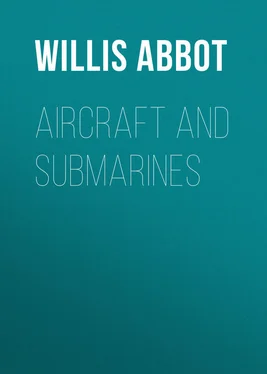Willis Abbot - Aircraft and Submarines
Здесь есть возможность читать онлайн «Willis Abbot - Aircraft and Submarines» — ознакомительный отрывок электронной книги совершенно бесплатно, а после прочтения отрывка купить полную версию. В некоторых случаях можно слушать аудио, скачать через торрент в формате fb2 и присутствует краткое содержание. Жанр: foreign_antique, foreign_prose, на английском языке. Описание произведения, (предисловие) а так же отзывы посетителей доступны на портале библиотеки ЛибКат.
- Название:Aircraft and Submarines
- Автор:
- Жанр:
- Год:неизвестен
- ISBN:нет данных
- Рейтинг книги:4 / 5. Голосов: 1
-
Избранное:Добавить в избранное
- Отзывы:
-
Ваша оценка:
- 80
- 1
- 2
- 3
- 4
- 5
Aircraft and Submarines: краткое содержание, описание и аннотация
Предлагаем к чтению аннотацию, описание, краткое содержание или предисловие (зависит от того, что написал сам автор книги «Aircraft and Submarines»). Если вы не нашли необходимую информацию о книге — напишите в комментариях, мы постараемся отыскать её.
Aircraft and Submarines — читать онлайн ознакомительный отрывок
Ниже представлен текст книги, разбитый по страницам. Система сохранения места последней прочитанной страницы, позволяет с удобством читать онлайн бесплатно книгу «Aircraft and Submarines», без необходимости каждый раз заново искать на чём Вы остановились. Поставьте закладку, и сможете в любой момент перейти на страницу, на которой закончили чтение.
Интервал:
Закладка:
We may pass over hastily some of the later experiments with dirigibles that failed. In 1834 the Count de Lennox built an airship 130 feet long to be driven by oars worked by man power. When the crowd that gathered to watch the ascent found that the machine was too heavy to ascend even without the men, they expressed their lively contempt for the inventor by tearing his clothes to tatters and smashing his luckless airship. In 1852, another Frenchman, Henry Giffard, built a cigar-shaped balloon 150 feet long by 40 feet in diameter, driven by steam. The engine weighed three hundred pounds and generated about 3 H. – P. – about 1/200 as much power as a gas engine of equal weight would produce. Even with this slender power, however, Giffard attained a speed, independent of the wind, of from five to seven miles an hour – enough at least for steerage way. This was really the first practical demonstration of the possibilities of the mechanical propulsion of balloons. Several adaptations of the Giffard idea followed, and in 1883 Renard and Krebs, in a fusiform ship, driven by an electric motor, attained a speed of fifteen miles an hour. By this time inventive genius in all countries – save the United States which lagged in interest in dirigibles – was stimulated. Germany and France became the great protagonists in the struggle for precedence and in the struggle two figures stand out with commanding prominence – the Count von Zeppelin and Santos-Dumont, a young Brazilian resident in Paris who without official countenance consecrated his fortune to, and risked his life in, the service of aviation.
CHAPTER III
THE SERVICES OF SANTOS-DUMONT
In his book My Airships the distinguished aviator A. Santos-Dumont tells this story of the ambition of his youth and its realization in later days:
I cannot say at what age I made my first kites, but I remember how my comrades used to tease me at our game of "pigeon flies." All the children gather round a table and the leader calls out "Pigeon Flies! Hen flies! Crow flies! Bee flies!" and so on; and at each call we were supposed to raise our fingers. Sometimes, however, he would call out "Dog flies! Fox flies!" or some other like impossibility to catch us. If any one raised a finger then he was made to pay a forfeit. Now my playmates never failed to wink and smile mockingly at me when one of them called "Man flies!" for at the word I would always raise my finger very high, as a sign of absolute conviction, and I refused with energy to pay the forfeit. The more they laughed at me the happier I was, hoping that some day the laugh would be on my side.
Among the thousands of letters which I received after winning the Deutsch prize (a prize offered in 1901 for sailing around the Eiffel Tower) there was one that gave me peculiar pleasure. I quote from it as a matter of curiosity:
"Do you remember, my dear Alberto, when we played together 'Pigeon Flies!'? It came back to me suddenly when the news of your success reached Rio. 'Man flies!' old fellow! You were right to raise your finger, and you have just proved it by flying round the Eiffel Tower.
"They play the old game now more than ever at home; but the name has been changed, and the rules modified since October 19, 1901. They call it now 'Man flies!' and he who does not raise his finger at the word pays the forfeit."
The story of Santos-Dumont affords a curious instance of a boy being obsessed by an idea which as a man he carried to its successful fruition. It offers also evidence of the service that may accrue to society from the devotion of a dilettante to what people may call a "fad," but what is in fact the germ of a great idea needing only an enthusiast with enthusiasm, brains, and money for its development. Because the efforts of Santos-Dumont always smacked of the amateur he has been denied his real place in the history of aeronautics, which is that of a fearless innovator, and a devoted worker in the cause.
Born on one of those great coffee plantations of Brazil, where all is done by machinery that possibly can be, Santos-Dumont early developed a passion for mechanics. In childhood he made toy airplanes. He confesses that his favourite author was Jules Verne, that literary idol of boyhood, who while writing books as wildly imaginative as any dime tale of redskins, or nickel novel of the doings of "Nick Carter" had none the less the spirit of prophecy that led him to forecast the submarine, the automobile, and the navigation of the air. At fifteen Santos-Dumont saw his first balloon and marked the day with red.
I too desired to go ballooning [he writes]. In the long sun-bathed Brazilian afternoons, when the hum of insects, punctuated by the far-off cry of some bird lulled me, I would lie in the shade of the veranda and gaze into the fair sky of Brazil where the birds fly so high and soar with such ease on their great outstretched wings; where the clouds mount so gaily in the pure light of day, and you have only to raise your eyes to fall in love with space and freedom. So, musing on the exploration of the aërial ocean, I, too, devised airships and flying-machines in my imagination.
From dreaming, the boy's ambitions rapidly developed into actions. Good South Americans, whatever the practice of their northern neighbours, do not wait to die before going to Paris. At the age of eighteen the youth found himself in the capital of the world. To his amazement he found that the science of aeronautics, such as it was, had stopped with Giffard's work in 1852. No dirigible was to be heard of in all Paris. The antiquated gas ball was the only way to approach the upper air. When the boy tried to arrange for an ascension the balloonist he consulted put so unconscionable a price on one ascent that he bought an automobile instead – one of the first made, for this was in 1891 – and with it returned to Brazil. It was not until six years later that, his ambition newly fired by reading of Andrée's plans for reaching the Pole in a balloon, Santos-Dumont took up anew his ambition to become an aviator. His own account of his first ascent does not bear precisely the hall-mark of the enthusiast too rapt in ecstasy to think of common things. "I had brought up," he notes gravely, "a substantial lunch of hard-boiled eggs, cold roast beef and chicken, cheese, ice cream, fruits and cakes, champagne, coffee, and chartreuse!"
The balloon with its intrepid voyagers nevertheless returned to earth in safety.
A picturesque figure, an habitué of the clubs and an eager sportsman, Santos-Dumont at once won the liking of the French people, and attracted attention wherever people gave thought to aviation. Liberal in expenditure of money, and utterly fearless in exposing his life, he pushed his experiments for the development of a true dirigible tirelessly. Perhaps his major fault was that he learned but slowly from the experiences of others. He clung to the spherical balloon long after the impossibility of controlling it in the air was accepted as unavoidable by aeronauts. But in 1898 having become infatuated with the performances of a little sixty-six pound tricycle motor he determined to build a cigar-shaped airship to fit it, and with that determination won success.
Amateur he may have been, was indeed throughout the greater part of his career as an airman. Nevertheless Santos-Dumont has to his credit two very notable achievements.
He was the first constructor and pilot of a dirigible balloon that made a round trip, that is to say returned to its starting place after rounding a stake at some distance – in this instance the Eiffel Tower, 3-½ miles from St. Cloud whence Santos-Dumont started and whither he returned within half an hour, the time prescribed.
This was not, indeed, the first occasion on which a round trip, necessitating operation against the wind on at least one course, had been made. In 1884 Captain Renard had accomplished this feat for the first time with the fish-shaped balloon La France , driven by an electric motor of nine horse-power. But though thus antedated in his exploit, Santos-Dumont did in fact accomplish more for the advancement and development of dirigible balloons. To begin with he was able to use a new and efficient form of motor destined to become popular, and capable, as the automobile manufacturers later showed, of almost illimitable development in the direction of power and lightness. Except for the gasoline engine, developed by the makers of motor cars, aviation to-day would be where it was a quarter of a century ago.
Читать дальшеИнтервал:
Закладка:
Похожие книги на «Aircraft and Submarines»
Представляем Вашему вниманию похожие книги на «Aircraft and Submarines» списком для выбора. Мы отобрали схожую по названию и смыслу литературу в надежде предоставить читателям больше вариантов отыскать новые, интересные, ещё непрочитанные произведения.
Обсуждение, отзывы о книге «Aircraft and Submarines» и просто собственные мнения читателей. Оставьте ваши комментарии, напишите, что Вы думаете о произведении, его смысле или главных героях. Укажите что конкретно понравилось, а что нет, и почему Вы так считаете.












